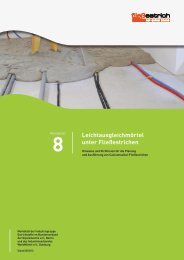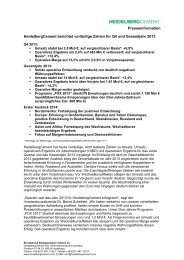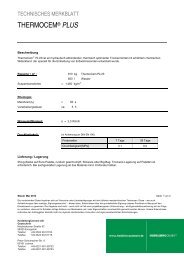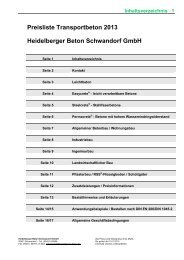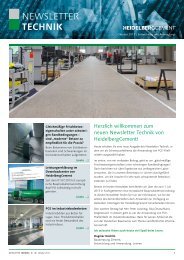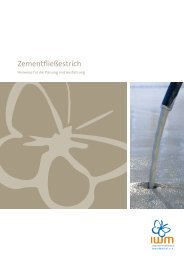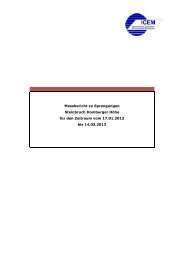Health and Safety Data Sheets for Cements and Cement Products
Health and Safety Data Sheets for Cements and Cement Products
Health and Safety Data Sheets for Cements and Cement Products
Create successful ePaper yourself
Turn your PDF publications into a flip-book with our unique Google optimized e-Paper software.
Uniclass<br />
L621:C506<br />
CI/SfB<br />
Eq2<br />
EPIC<br />
F2112:Y44<br />
(U47)<br />
Aug 09<br />
<strong>Health</strong> <strong>and</strong> <strong>Safety</strong> data sheet <strong>for</strong> Common <strong><strong>Cement</strong>s</strong> <strong>and</strong> <strong>Cement</strong> <strong>Products</strong><br />
www.hanson.com/uk
<strong>Health</strong> <strong>and</strong> <strong>Safety</strong> <strong>Data</strong> sheet <strong>for</strong> Common <strong><strong>Cement</strong>s</strong> <strong>and</strong> <strong>Cement</strong> <strong>Products</strong><br />
1. IDENTIFICATION OF THE SUBSTANCE/<br />
PREPARATION AND OF THE COMPANY /<br />
UNDERTAKING<br />
1.1 Identification of substance/preparation<br />
<strong>Cement</strong>. An odourless white to grey powder slightly<br />
soluble in water.<br />
This data sheet applies to the following products<br />
containing cement: Castle Multicem; Castle <strong>Cement</strong>;<br />
Castle Ordinary Portl<strong>and</strong> <strong>Cement</strong> (OPC); Castle<br />
High Strength 52,5; Hanson/Castle Rapid Hardening<br />
Portl<strong>and</strong> <strong>Cement</strong> (RHPC); Castle Sulfate-resisting;<br />
Castle/Hanson White <strong>Cement</strong>; Castle Masonry;<br />
Castle Quickcem; Hanson/Castle High Alumina;<br />
Castle Portl<strong>and</strong> – Limestone <strong>Cement</strong>; Castle<br />
Portl<strong>and</strong> – Fly Ash <strong>Cement</strong>; Castle General Purpose<br />
Grouts; Castle Depocrete; Castle Protomix; Hanson<br />
multipurpose concrete; Hanson 40N concrete;<br />
Hanson Postfix; Castle Readybag High Per<strong>for</strong>mance<br />
Post Mix <strong>and</strong> Hanson S<strong>and</strong> <strong>Cement</strong> Mortar.<br />
1.2 Use of the substance/preparation<br />
Common cement is used as a hydraulic binder <strong>for</strong> the<br />
production of concrete, mortars, grout etc.<br />
1.3 Company identification<br />
Hanson <strong>Cement</strong> Limited<br />
Ketton<br />
Stam<strong>for</strong>d<br />
Lincolnshire<br />
PE9 3SX<br />
Hanson <strong>Cement</strong> Technical Helpline<br />
tel: 0845 722 7853<br />
fax: 01780 727154<br />
e-mail: cement.technical.help@hanson.biz<br />
1.4 Emergency telephone<br />
Telephone: 0845 722 7853<br />
2. HAZARDS IDENTIFICATION<br />
When cement is mixed with water such as when making<br />
concrete or mortar, or when the cement becomes damp,<br />
a strong alkaline solution is produced. If this comes into<br />
contact with the eyes or skin it may cause serious burns <strong>and</strong><br />
ulceration. The eyes are particularly vulnerable <strong>and</strong> damage<br />
will increase with contact time.<br />
2.1 Hazard characterisation<br />
Xi Irritant<br />
R37/38 Irritating to respiratory system <strong>and</strong> skin<br />
R41 Risk of serious damage to eyes<br />
R43 May cause sensitisation by skin contact<br />
2.2 Primary routes of entry<br />
Inhalation: Yes<br />
Skin/eyes:<br />
Ingestion:<br />
Yes<br />
No, except in accidental cases<br />
2.3 Human health<br />
Inhalation: Frequent inhalation of large quantities of<br />
cement dust over a long period of time increases the<br />
risk of developing lung diseases.<br />
Eyes: Eye contact with cement (dry or wet) may<br />
cause serious <strong>and</strong> potentially irreversible injuries.<br />
Skin: Strong alkaline solutions in contact with the<br />
skin tend to damage the nerve endings first be<strong>for</strong>e<br />
damaging the skin, there<strong>for</strong>e chemical burns can<br />
develop without pain being felt at the time. Hence,<br />
prolonged skin contact with wet cement, fresh<br />
concrete or mortar may cause serious burns.<br />
<strong>Cement</strong>, mortar <strong>and</strong> concrete mixes may, until set,<br />
cause irritant dermatitis: Irritant contact dermatitis is<br />
due to a combination of the wetness, alkalinity <strong>and</strong><br />
abrasiveness of the constituent materials. If used<br />
outside of the declared shelf life, there may be a risk<br />
of allergic dermatitis. Allergic dermatitis is caused<br />
mainly by the sensitivity of an individual’s skin to<br />
soluble chromium (VI).<br />
2.4 Environment<br />
Under normal use, the product is not expected to be<br />
hazardous to the environment.<br />
3. COMPOSITION/ INFORMATION ON INGREDIENTS<br />
3.1 Chemical composition<br />
Common cement types according to the EN 197-1<br />
(Common cements <strong>and</strong> EN 197- 4 (Blast furnace<br />
cements).The principal constituents of these cements<br />
are calcium silicates, aluminates, ferro-aluminates<br />
<strong>and</strong> sulfates. Small amounts of alkalis, lime, magnesia<br />
<strong>and</strong> chlorides are also present together with trace<br />
amounts of chromium compounds. Additional<br />
constituents may also be present e.g. pulverised-fuel<br />
ash, limestone, clay <strong>and</strong> granulated blast furnace<br />
slag.<br />
3.2 Components presenting a health hazard<br />
Substance<br />
Portl<strong>and</strong><br />
<strong>Cement</strong><br />
Clinker<br />
Concentration<br />
range<br />
(by weight<br />
in cement)<br />
EINECS CAS Symbol<br />
(C&L)<br />
5 – 95% 266-043-4 65997-15-1 Xi R37<br />
R38<br />
R41<br />
R43<br />
R<br />
www.hanson.com/uk
<strong>Health</strong> <strong>and</strong> <strong>Safety</strong> <strong>Data</strong> sheet <strong>for</strong> Common <strong><strong>Cement</strong>s</strong> <strong>and</strong> <strong>Cement</strong> <strong>Products</strong><br />
4. FIRST AID MEASURES<br />
If medical advice is sought take this safety datasheet<br />
with you.<br />
4.1 Inhalation<br />
If irritation occurs, move to fresh air. If nose or<br />
airways become inflamed seek medical advice.<br />
4.2 Eye contact<br />
A speedy response is essential in order to avoid<br />
permanent damage to the eyes. Wash eyes<br />
immediately with plenty of clean water <strong>for</strong> at least 15<br />
minutes <strong>and</strong> seek medical advice without delay.<br />
4.3 Skin contact<br />
Wash the affected area thoroughly with soap <strong>and</strong><br />
water be<strong>for</strong>e continuing. If irritation, pain or other<br />
skin trouble occurs, seek medical advice. Clothing,<br />
footwear, watches etc contaminated by wet cement,<br />
concrete or mortar should be removed <strong>and</strong> washed<br />
thoroughly be<strong>for</strong>e use.<br />
4.4 Ingestion<br />
Do not induce vomiting. If person is conscious,<br />
wash out mouth with water <strong>and</strong> give plenty of water<br />
to drink. After significant ingestion seek immediate<br />
medical attention.<br />
5. FIRE-FIGHTING MEASURES<br />
<strong><strong>Cement</strong>s</strong> are non-flammable <strong>and</strong> non-explosive. They will<br />
not facilitate combustion with other materials <strong>and</strong> all types<br />
of extinguishing media are suitable. No additional specialist<br />
equipment is required by fire fighters.<br />
6. ACCIDENTAL RELEASE MEASURES<br />
6.1 Personal protective measures<br />
Wear protective equipment as described under<br />
Heading 8 <strong>and</strong> follow the advice <strong>for</strong> safe h<strong>and</strong>ling<br />
<strong>and</strong> use given under Heading 7.<br />
6.2 Environmental protection measures<br />
Do not wash cement down sewage <strong>and</strong> drainage<br />
systems or into bodies of water (e.g. streams).<br />
6.3 Methods <strong>for</strong> cleaning up<br />
Recover the spillage in a dry state if possible. Keep<br />
children away from clean up operations.<br />
Dry cement<br />
• Use dry clean up methods that do not cause<br />
airborne dispersion, <strong>for</strong> example an industrial<br />
vacuum cleaner equipped with high efficiency<br />
particulate filters (HEPA filter) or an equivalent<br />
technique or;<br />
• Clear up the dust by mopping, wet brushing or<br />
by spraying with water (fine mist to avoid the dust<br />
becoming airborne) <strong>and</strong> remove slurry.<br />
Wet cement<br />
Clean up wet cement <strong>and</strong> place in a container.<br />
Allow material to dry <strong>and</strong> solidify be<strong>for</strong>e disposal<br />
as described under Heading 13<br />
7. HANDLING & STORAGE<br />
7.1 H<strong>and</strong>ling<br />
When h<strong>and</strong>ling cement bags, due regard should<br />
be paid to the risks outlined in the Manual H<strong>and</strong>ling<br />
Operations Regulations. Some bags may have<br />
a small amount of cement on the outer surface.<br />
Appropriate personal protective clothing (see<br />
Heading 8) should there<strong>for</strong>e be used whilst h<strong>and</strong>ling.<br />
Avoid generating dust:-<br />
For bagged cement used in open ended mixers:<br />
first add water <strong>and</strong> then carefully add the cement.<br />
Keep the height of the fall low. Start the mixing<br />
smoothly. Do not compress empty bags, except<br />
when contained in another clean bag<br />
7.2 Storage<br />
Bulk cement must be stored in silos that are<br />
waterproof, clean <strong>and</strong> protected from contamination,<br />
dry (internal condensation minimised) with stock<br />
rotated in chronological order of the despatch dates<br />
marked on delivery tickets.<br />
Engulfment Hazard: To prevent burial or suffocation,<br />
do not enter a confined space, such as a silo, bin or<br />
bulk truck, or other storage container or vessel that<br />
stores or contains cement without taking the proper<br />
safety measures. <strong>Cement</strong> can build-up or adhere<br />
to the walls of a confined space. The cement can<br />
release, collapse or fall unexpectedly.<br />
Packed products must be stored in unopened bags<br />
clear of the ground in cool, dry conditions <strong>and</strong><br />
protected from excessive draught. Bags should be<br />
stacked in a safe <strong>and</strong> stable manner.<br />
7.3 Control of soluble Chromium (VI)<br />
For cements treated with a Cr (VI) reducing agent<br />
according to the regulations given in Heading 15,<br />
the effectiveness of the reducing agent diminishes<br />
with time. There<strong>for</strong>e cement bags <strong>and</strong>/or delivery<br />
documents will contain in<strong>for</strong>mation on the period of<br />
time (shelf life) <strong>for</strong> which the reducing agent will<br />
continue to maintain the level of soluble Cr (VI)<br />
below the imposed limit of 0.0002%, according to<br />
EN 197-10. They will also indicate the appropriate<br />
storage conditions <strong>for</strong> maintaining the effectiveness<br />
of the reducing agent.<br />
www.hanson.com/uk
<strong>Health</strong> <strong>and</strong> <strong>Safety</strong> <strong>Data</strong> sheet <strong>for</strong> Common <strong><strong>Cement</strong>s</strong> <strong>and</strong> <strong>Cement</strong> <strong>Products</strong><br />
8. EXPOSURE CONTROLS/PERSONAL PROTECTION<br />
8.1 Exposure limit values<br />
WEL 8hr Time Weighted Average (TWA)<br />
10mg/m3 total inhalable dust<br />
4mg/m3 respirable dust<br />
8.2 Exposure controls<br />
8.2.1 Occupational exposure controls<br />
Respiratory protection: Suitable respiratory<br />
protection should be worn to ensure that<br />
personal exposure is less than the WEL. This<br />
should con<strong>for</strong>m to the relevant EN st<strong>and</strong>ard.<br />
Eye protection: Dust-proof goggles should be<br />
worn wherever there is a risk of cement powder<br />
or any cement/water mixture entering the eye.<br />
This should con<strong>for</strong>m to EN 166.<br />
H<strong>and</strong> <strong>and</strong> skin protection: Use waterproof,<br />
abrasion <strong>and</strong> alkali resistant gloves.<br />
Waterproof clothing gloves <strong>and</strong> boots should<br />
be worn which ensure that cement, or any<br />
cement/water mixture, e.g. concrete or mortar,<br />
does not come into contact with the skin. In<br />
some circumstances such as when laying<br />
concrete, waterproof trousers <strong>and</strong> wellingtons<br />
may be necessary. Particular care should be<br />
taken to ensure that wet concrete does not<br />
enter the boots <strong>and</strong> persons do not kneel<br />
on the wet concrete so as to bring the wet<br />
concrete into contact with unprotected skin.<br />
Should wet mortar or wet concrete get inside<br />
boots, gloves or other protective clothing then<br />
this protective clothing should be immediately<br />
removed <strong>and</strong> the skin thoroughly washed as<br />
well as the protective clothing/footwear.<br />
Do not eat, drink or smoke when working with<br />
cement to avoid contact with the skin or mouth.<br />
Immediately after working with cementcontaining<br />
materials, workers should wash,<br />
shower or use skin moisturisers. Remove<br />
contaminated clothing, footwear, watches etc<br />
<strong>and</strong> clean thoroughly be<strong>for</strong>e re-using them.<br />
8.2.1 Environmental exposure controls<br />
According to available technology.<br />
9. PHYSICAL AND CHEMICAL PROPERTIES<br />
9.1 General in<strong>for</strong>mation<br />
Dry cement is a finely ground inorganic material<br />
(odourless, grey or white powder).<br />
9.2 Physical data<br />
Mean particle size:<br />
Solubility in water (T=20 oC):<br />
5-30 microns<br />
slight (0.1-1.5 g/l)<br />
Density:<br />
Apparent density (ES):<br />
pH (T=20 oC in water): 11-13.5<br />
Boiling/melting point:<br />
2750-3200 kg/m3<br />
900-1500 kg/m3<br />
>1250 oC<br />
Vapour pressure, vapour density, evaporation<br />
rate, freezing point, viscosity, flash point (not<br />
flammable), explosive properties (not explosive): Not<br />
relevant<br />
10. STABILITY AND REACTIVITY<br />
10.1 Conditions to avoid<br />
Dry cements are stable as long as they are stored<br />
properly (see Heading 7) <strong>and</strong> are compatible with<br />
most other building materials. When mixed with<br />
water, cements will harden into a stable mass that is<br />
not reactive to normal environments.<br />
10.2 Materials to avoid<br />
Uncontrolled use of aluminium powder in wet cement<br />
should be avoided as hydrogen is produced.<br />
10.3 Hazardous decomposition products<br />
<strong><strong>Cement</strong>s</strong> will not decompose into other hazardous<br />
by-products <strong>and</strong> do not polymerise.<br />
11. TOXICOLOGICAL INFORMATION<br />
11.1 Short term effects<br />
a) Eye contact – cement is a severe eye irritant. Mild<br />
exposure can cause soreness. Gross exposures<br />
or untreated mild exposures can lead to chemical<br />
burning <strong>and</strong> ulceration of the eye.<br />
b) Skin contact – cement powder or any cement/<br />
water mixture may cause chemical burns <strong>and</strong>/or<br />
irritant contact dermatitis. If used outside of the<br />
declared shelf life, there may be risk of allergic<br />
dermatitis.<br />
c) Acute dermal toxicity: Acute dermal toxicity: limit<br />
test, rabbit, 24 hours contact, 2.000 mg/kg body<br />
weight – no lethality [Reference (2)].<br />
d) Ingestion – the swallowing of small amounts of<br />
cement or any cement/water mixtures is unlikely to<br />
cause any significant reaction. Larger doses may<br />
result in irritation to the gastrointestinal tract.<br />
e) Inhalation – cement powder may cause<br />
inflammation of mucous membranes. Coughing,<br />
sneezing <strong>and</strong> shortness of breath may occur<br />
following exposures in excess of occupational<br />
exposure limits.<br />
www.hanson.com/uk
<strong>Health</strong> <strong>and</strong> <strong>Safety</strong> <strong>Data</strong> sheet <strong>for</strong> Common <strong><strong>Cement</strong>s</strong> <strong>and</strong> <strong>Cement</strong> <strong>Products</strong><br />
11.2 Chronic effects<br />
a) Inhalation – Chronic exposure to respirable dust in<br />
excess of occupational exposure limits may cause<br />
coughing, shortness of breath <strong>and</strong> may cause<br />
chronic obstructive lung disease (COPD)<br />
b) Carcinogenicity – a casual association between<br />
cement exposure <strong>and</strong> cancer has not been<br />
established [reference (1)].<br />
c) Contact dermatitis/Sensitising effects – Some<br />
individuals may exhibit eczema upon exposure<br />
to wet cement caused either by the high pH<br />
which induces irritant contact dermatitis, or by an<br />
immunological reaction to soluble Cr (VI) which<br />
elicits allergic contact dermatitis [Reference (4)].<br />
The response may appear in a variety of <strong>for</strong>ms<br />
ranging from a mild rash to severe dermatitis <strong>and</strong><br />
is a combination of those two mechanisms. An<br />
exact diagnosis is often difficult. If the cement<br />
contains a soluble Cr (VI) reducing agent <strong>and</strong> as<br />
long as the mentioned period of effectiveness is<br />
not exceeded, a sensitising effect is not expected<br />
[Reference (3)].<br />
11.3 Medical conditions aggravated by exposure<br />
Inhaling cement dust may aggravate existing<br />
respiratory system disease(s) <strong>and</strong>/or medical<br />
conditions such as emphysema or asthma <strong>and</strong>/or<br />
existing skin <strong>and</strong>/or eye conditions.<br />
12. ECOLOGICAL INFORMATION<br />
12.1 Ecotoxicity<br />
The product is not expected to be hazardous to<br />
the environment (LC50 aquatic toxicity rating not<br />
determined). The addition of cements to water will,<br />
however, cause the pH to rise <strong>and</strong> may there<strong>for</strong>e be<br />
toxic to aquatic life in some circumstances.<br />
12.2 Mobility<br />
Dry cement is not volatile but might become airborne<br />
during h<strong>and</strong>ling operations.<br />
12.3 Persistence <strong>and</strong> degradability/Bio<br />
accumulative potential/results of PBT<br />
assessment/other adverse effects<br />
Not relevant. After hardening, cement presents no<br />
toxicity risks.<br />
13. DISPOSAL CONSIDERATIONS<br />
13.1 Product – cement that has exceeded its<br />
shelf life<br />
When demonstrated that it contains more than<br />
0,0002% soluble Cr (VI): shall not be used/sold<br />
other than <strong>for</strong> use in controlled closed <strong>and</strong> totally<br />
automated processes or should be recycled or<br />
disposed of according to current National or<br />
Devolved Administration legislation or treated again<br />
with a reducing agent.<br />
13.2 Product – unused residue or dry spillage<br />
Pick up dry. Mark the containers. Possibly re-use<br />
depending upon shelf life considerations <strong>and</strong> the<br />
requirement to avoid dust exposure. In case of<br />
disposal, harden with water <strong>and</strong> dispose according<br />
to 13.4.<br />
13.3 Product - slurries<br />
Allow to harden, avoid entry in sewage <strong>and</strong> drainage<br />
systems or into bodies of water (e.g. streams) <strong>and</strong><br />
dispose of as indicated in 13.4.<br />
13.4 Product – after addition of water, hardened<br />
Dispose of according to the current National or<br />
Devolved Administration legislation. Avoid entry into<br />
the sewage water system.<br />
13.5 Packaging<br />
Completely empty the packaging <strong>and</strong> process<br />
it according to current National or Devolved<br />
Administration legislation.<br />
14. TRANSPORT INFORMATION<br />
<strong>Cement</strong> is not covered by the international regulation<br />
on the transport of dangerous goods (IMDG, IATA,<br />
ADR/RID), no classification is required. No special<br />
precautions are needed apart from those mentioned<br />
under Heading 8.<br />
15. REGULATORY INFORMATION<br />
15.1 Classification <strong>and</strong> labelling of cement<br />
according to 1999/45/EC<br />
Xi Irritant<br />
Xi IRRITANT<br />
Risk phrases<br />
• Risk of serious damage to eyes.<br />
• Skin contact with wet cement, fresh concrete or<br />
mortar may cause irritation, dermatitis or burns.<br />
• Contact between cement powder <strong>and</strong> body fluids<br />
(e.g. sweat <strong>and</strong> eye fluid) may also cause skin <strong>and</strong><br />
respiratory irritation, dermatitis or burns.<br />
www.hanson.com/uk
<strong>Health</strong> <strong>and</strong> <strong>Safety</strong> <strong>Data</strong> sheet <strong>for</strong> Common <strong><strong>Cement</strong>s</strong> <strong>and</strong> <strong>Cement</strong> <strong>Products</strong><br />
• Contains chromium (VI). May produce an allergic<br />
reaction.<br />
<strong>Safety</strong> phrases<br />
• Avoid eye <strong>and</strong> skin contact by wearing suitable<br />
eye protection, waterproof clothing, waterproof<br />
footwear <strong>and</strong> waterproof gloves.<br />
• Clothing contaminated by wet cement should be<br />
removed immediately <strong>and</strong> washed be<strong>for</strong>e re-use.<br />
• Avoid breathing dust.<br />
• Keep out of reach of children.<br />
• On contact with eyes or skin, rinse immediately<br />
with plenty of clean water. Seek medical advice<br />
after eye contact.<br />
15.2 The marketing <strong>and</strong> use of cement is subject to<br />
a restriction on the content of soluble Cr (VI)<br />
15.3 UK legislation/requirements<br />
• CONIAC <strong>Health</strong> Hazard In<strong>for</strong>mation Sheet No. 26<br />
(CEMENT)<br />
• <strong>Health</strong> <strong>and</strong> <strong>Safety</strong> at Work etc Act 1974<br />
• Control of Substances Hazardous to <strong>Health</strong><br />
(Regulations)<br />
• PORTLAND CEMENT DUST – criteria document<br />
<strong>for</strong> an occupational exposure limit. June 1994<br />
(ISBN 07176 – 0763 – 1)<br />
• HSE Guidance Notes EH26 (Occupational Skin<br />
Diseases – <strong>Health</strong> <strong>and</strong> <strong>Safety</strong> Precautions)<br />
• HSE Guidance Note EH40 (Workplace Exposure<br />
Limits)<br />
• Any authorised manual on First Aid by St. John’s/<br />
St. Andrew’s/Red Cross<br />
• Manual H<strong>and</strong>ling Operations Regulations<br />
• Environmental Protection Act<br />
16. OTHER INFORMATION<br />
Abbreviations<br />
• IMDG: International Maritime Dangerous Goods<br />
• IATA: International Air Transport Association<br />
• ADR/RID: Agreement on the transport of<br />
dangerous goods by road/Regulations on the<br />
international transport of dangerous goods by rail<br />
• LC50 Lethal Concentration where 50% of the test<br />
animals die.<br />
• OEL occupational exposure limit<br />
• WEL workplace exposure limit<br />
• TWA: Time Weighted Averages<br />
References<br />
(1) Portl<strong>and</strong> <strong>Cement</strong> Dust - Hazard assessment<br />
document EH75/7, UK <strong>Health</strong> <strong>and</strong> <strong>Safety</strong><br />
Executive, 2006. Available from: http://www.hse.<br />
gov.uk/pubns/web/portl<strong>and</strong>cement.pdf<br />
(2) Observations on the effects of skin irritation<br />
caused by cement, Kietzman et al, Dermatosen,<br />
47, 5, 184-189 (1999).<br />
(3) European Commission’s Scientific Committee on<br />
Toxicology, Ecotoxicology <strong>and</strong> the Environment<br />
(SCTEE) opinion of the risks to health from Cr<br />
(VI) in cement (European Commission, 2002).<br />
(4) Epidemiological assessment of the occurrence of<br />
allergic dermatitis in workers in the construction<br />
industry related to the content of Cr(VI) in<br />
cement, NIOH, Page 11, 2003.<br />
The in<strong>for</strong>mation on this data sheet reflects the<br />
currently available knowledge <strong>and</strong> is reliable provided<br />
that the product is used under the prescribed<br />
conditions <strong>and</strong> in accordance with the application<br />
specified on the packaging <strong>and</strong>/or in the technical<br />
guidance literature. Any other use of the product,<br />
including the use of the product in combination<br />
with any other product or any other process, is the<br />
responsibility of the user. It is implicit that the user<br />
is responsible <strong>for</strong> determining appropriate safety<br />
measures <strong>and</strong> <strong>for</strong> applying the legislation covering<br />
their own activities.<br />
Please note: Reference to a Technical St<strong>and</strong>ard number in this leaflet is deemed to include the latest published edition <strong>and</strong>/or any published amendments issued after the st<strong>and</strong>ard’s publication, unless a date<br />
of issue is quoted in which case reference is to the provisions stated in that edition.<br />
L006(Ck)/08/09/pdf<br />
For further in<strong>for</strong>mation<br />
please contact:<br />
Hanson <strong>Cement</strong><br />
Ketton<br />
Stam<strong>for</strong>d<br />
Lincolnshire<br />
PE9 3SX<br />
Technical Helpline:<br />
Tel: 0845 722 7853<br />
(calls charged at local rate)<br />
Fax: 01780 727154<br />
Email: cement.technical.help@hanson.biz<br />
Customer Services:<br />
Tel: 0845 600 1616<br />
(calls charged at local rate)<br />
Fax: 01780 727008<br />
Email: cement.customer.services@hanson.biz<br />
www.hanson.com/uk





